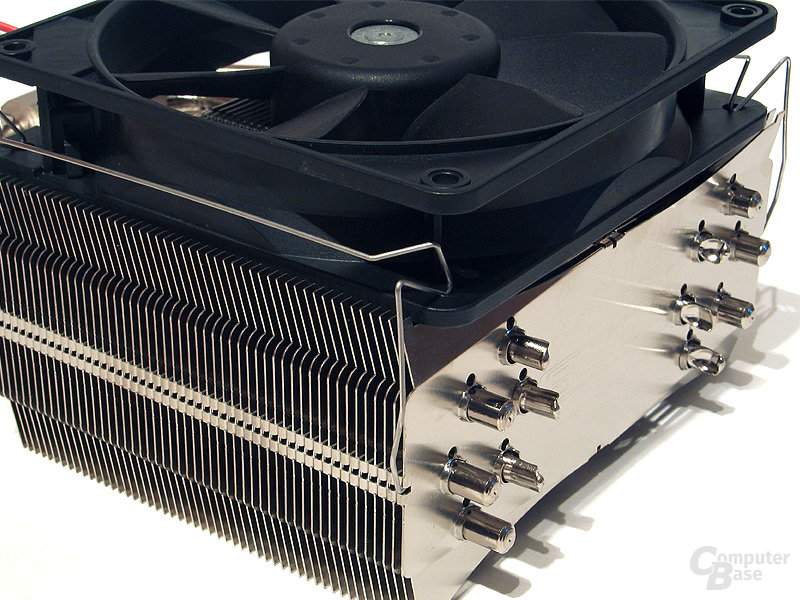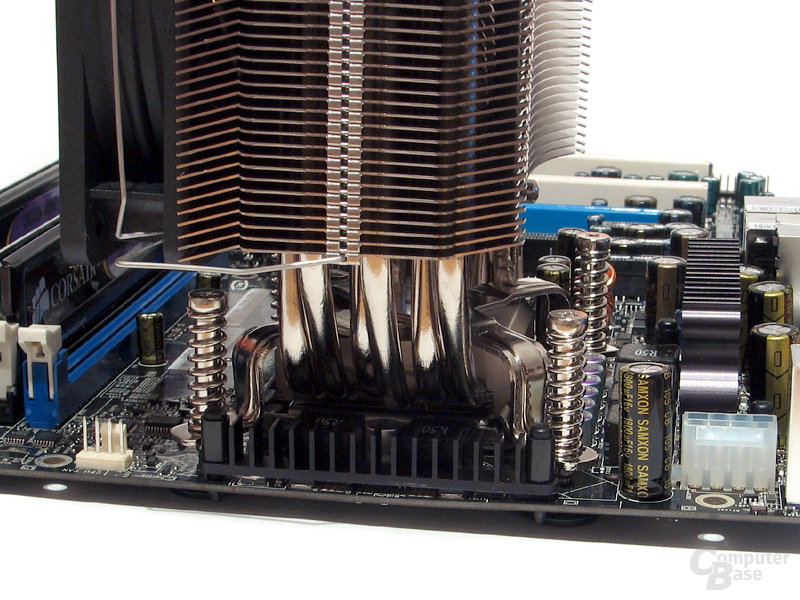Although Thermalright had an excellent cooler on the market with the Ultra-120, inexpensive and excellent competitor models such as Scythe made life difficult for the manufacturer in 2007. The counterattack followed with the Thermalright Ultra-120 Extreme (test), which took cooling performance and price to a new level.
Table of contents
- A monster with six heat pipes
- Top performance in three scenarios
- Conclusion
A monster with six heatpipes
Thermalright didn't do things by halves with the Ultra-120 Extreme: The 790 g (without fan) heavy cooler with dimensions of 63.5 × 132 × 160.5 mm (L × W × H) was equipped with six U-shaped 6 mm – Equipped with heat pipes. Compared to its predecessor, there were two more heat pipes that dissipated the heat from the copper base plate to the aluminum fins. As usual with Thermalright, the cooler, which costs around 50 euros, did not come with a fan, so users had to purchase a suitable 120 mm model as well. Fans could be attached to the nickel-plated cooling tower on both sides using a wire bracket.
-
 Slightly angled slat edges for better airflow
Slightly angled slat edges for better airflow
Image 1 of 6
 Fan attachment with wire bracket, not ideal because it's a bit wobbly
Fan attachment with wire bracket, not ideal because it's a bit wobbly Wire bracket mount does not allow every fan installation
Wire bracket mount does not allow every fan installation Screw connection with spring screws ensures high contact pressure
Screw connection with spring screws ensures high contact pressureThe assembly of the Ultra-120 Extreme turned out to be largely problem-free – as long as there was enough space available. Due to the expansive dimensions, the cooler tended to collide with all sorts of other components. Mainboards with protruding coolers as well as cases that didn't offer enough space for a 161 mm high cooler caused him problems. In addition, a special backplate had to be purchased for some ASRock and Gigabyte mainboards that were not delivered with the AMD standard backplate Peak performance in three scenarios
The Ultra-120 Extreme cut an excellent figure on an Intel Core 2 Extreme QX6700 with four cores each running at 2.66 GHz. In the test 15 years ago, it competed in three different scenarios with different fans. The 120mm low-speed reference fan was a Scythe S-Flex SFF21D at ~750 rpm, a Papst F2GLL at mid-range at ~1,140 rpm and a Sharkoon Power at ~2,100 rpm at high-speed. at least In two out of three of these configurations, the Thermalright Ultra-120 Extreme took the lead in the test field. In the third case, the high speed range, it was beaten by 0.25 Kelvin by the Zalman CNPS 9700 LED, which, however, was equipped with a different fan due to its design. The next-placed cooler with the same fan was the Xigmatek HDT-S1283, which was beaten by 0.5 Kelvin.
Super Silent Configuration [< 31 dB(A)]
[Fan] Speed
[RPM] Load temp.
Cores* [°C] Sound pressure
[dB(A)] Thermalright Ultra-120 eXtr.
[120 mm Scythe S-Flex SFF21D] 750 72.25 30.4 Xigmatek HDT-S1283
[120mm Scythe S-Flex SFF21D] 750 72.5 30.4 Scythe Mugen Heatsink
[120mm Scythe S-Flex SFF21D] 750 73.5 30.4 Thermalright Ultra-120
[ 120mm Scythe S-Flex SFF21D] 750 75.75 30.4 Scythe Katana 2
[100mm stock fan] 830 90.5 30.4
Quiet to medium configuration [< 40 dB(A)]
[Fan] Speed
[RPM] Load temp.
cores* [°C] sound pressure
[dB(A)] Thermalright Ultra-120 eXtr.
[120mm Pope F2GLL] 1150 67.0 31.6 Xigmatek HDT-S1283
[120mm Pope F2GLL] 1150 67.25 31.2 Scythe Mugen Heatsink
[120mm Papst F2GLL] 1150 68.5 31.4 Zalman CNPS 9700 LED
[110mm Stock Fan] 1250 69.25 33.3 Thermalright Ultra-120
[ 120mm Pope F2GLL] 1150 70.75 31.6 Zalman CNPS 9500 LED
[92mm Stock Fan] 1400 75.75 32.9 Scythe Katana 2
[100mm Stock Fan] 1550 78, 5 34.6
Power Configuration [> 40 dB(A)]
[Fan] Speed
[RPM] Load Temp.
Cores* [°C] Sound pressure
[dB(A)] Zalman CNPS 9700 LED
[110 mm series fan] 2250 62.25 49.9 Thermalright Ultra-120 eXtr.< /strong>
[120mm Sharkoon Power] 2100 62.5 49.2 Xigmatek HDT-S1283
[120mm Sharkoon Power] 2100 63.0 48.8 Scythe Mugen Heatsink
[ 120mm Sharkoon Power] 2100 63.75 49.0 Thermalright Ultra 120
[120mm Sharkoon Power] 2100 66.25 49.2 Zalman CNPS 9500 LED
[92mm stock fan] 2250 69.5 47.1
* This was the arithmetic mean of the core temperatures of the four native cores of the test processor used to generate ranking in the charts.
Conclusion
The Thermalright Ultra-120 Extreme gave little cause for criticism. The processing was excellent, the cooling performance was unbeatable and the design was simple and elegant. Everyone had to decide for themselves whether the comparatively small advantages compared to a significantly cheaper Xigmatek HDT-S1283 or Scythe Mugen justified the surcharge. In October 2007, anyone who didn't want to compromise on cooling performance (given money and enough space) couldn't buy a better air cooler than the Thermalright Ultra-120 Extreme.
In the category “In the test 15 years ago”, the editors have been taking a look at the test archive every Saturday since July 2017. The last 20 articles that appeared in this series are listed below:
- 249 euros were too much for the Radeon HD 2600 XT X2< /li>
- Teufels elegant 2.1 system with excellent sound
- Arctic Cooling's Accelero S1 was colder than the competition
- Zalman wanted to reinvent himself and failed
- Cool Masters Cosmos at an astronomical price
- The best multimedia keyboard came from Microsoft
- Sparkles Caliber GeForce 8600 GT ran far from the norm
- Xigmatek was on the road to success with the HDT-S1283
- Movie playback on GPUs from ATi versus Nvidia
- Teufel and Logitech in a 5.1 exchange of blows
- Scythe's Katana 2 was the cooler king of the middle class
- An almost inaudible gaming PC for 3,100 Euro
- Corsair's Voyager GT was the best USB stick for 100 Euro
- HD 2000 with RV610 & RV630 convinced more than with R600
- DDR3 celebrated its premiere with the Intel P35 at Asus
- ATi CrossFire was 80 percent ahead – measured in dB(A)
- Halo 2 was a flop on the PC despite Vista
- Router, switch and NAS in one from Asus
- Xigmatek stirred up the market for 25 euros with Direct-Touch
- The best gaming mouse was Razer's Death Adder
You can find even more content of this kind and many more reports and anecdotes in the retro corner in the forum of ComputerBase.